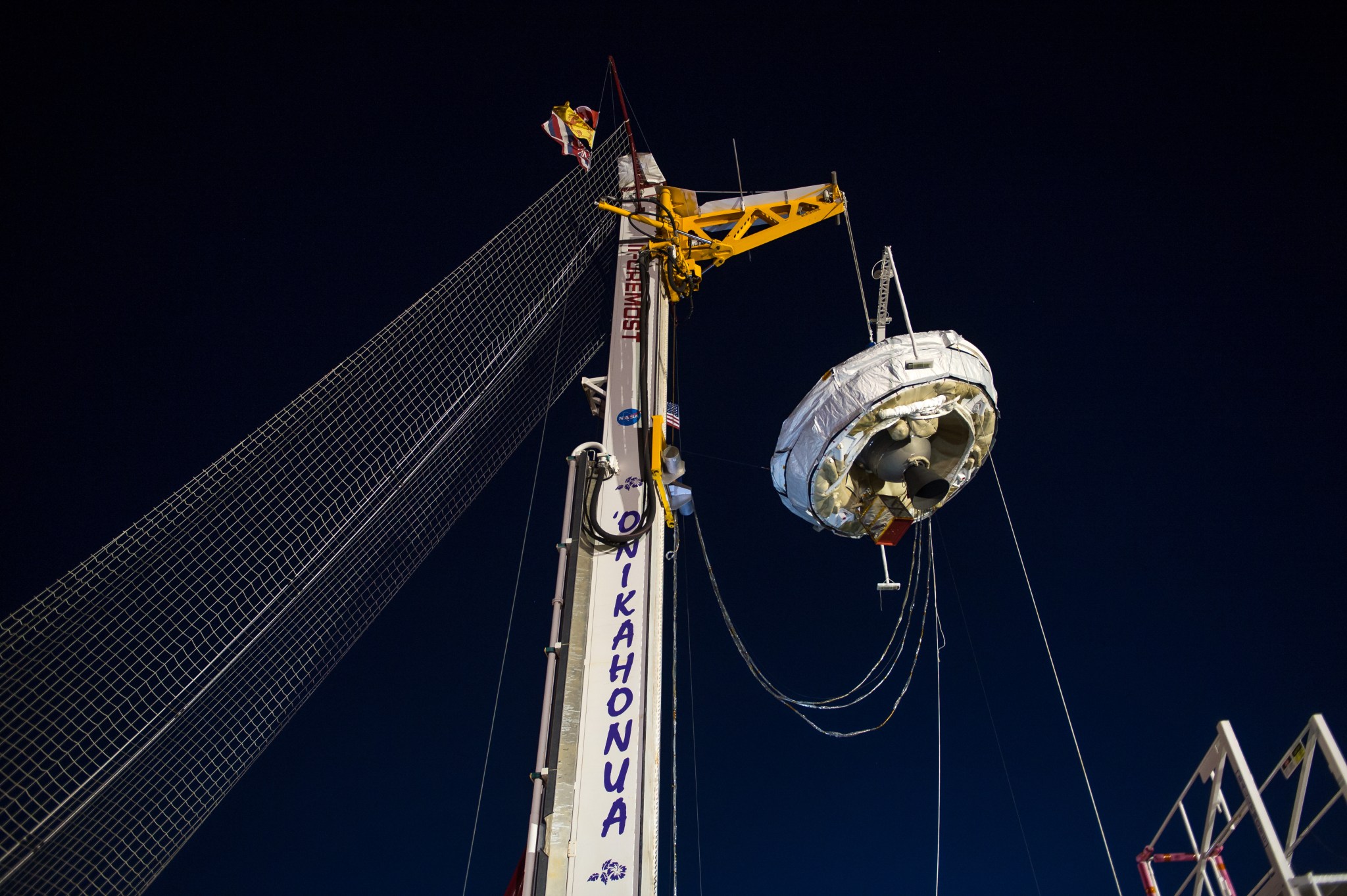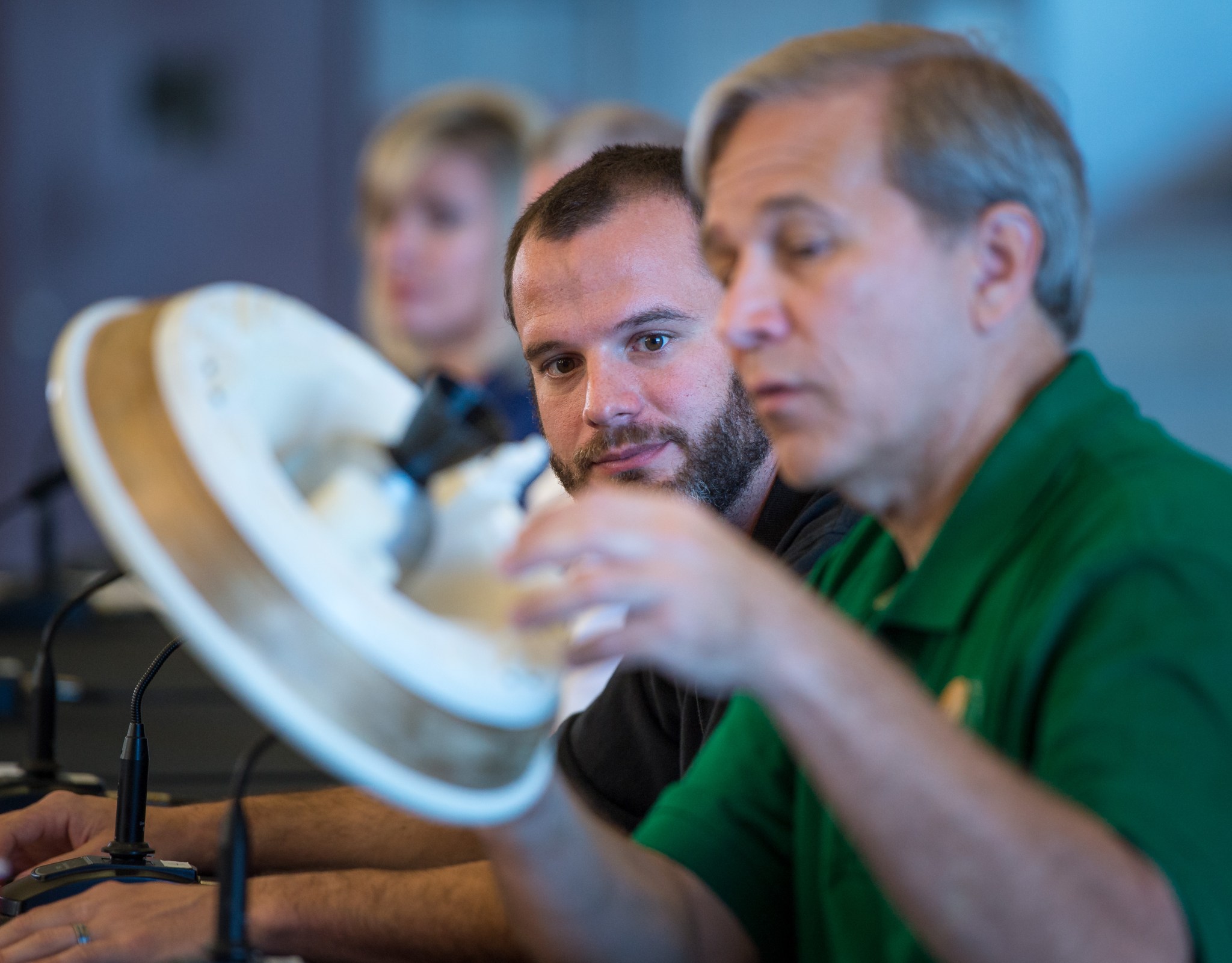When NASA’s Low-Density Supersonic Decelerator test vehicle flew high over the Pacific Ocean June 8 to test two innovative aerobraking technologies, it did so thanks to the tenacity and ingenuity of workers at a host of NASA facilities, military installations and specialized companies that very nearly stretches from sea to shining sea.
The LDSD flight tested breakthrough technologies for landing future robotic and human missions on Mars and safely returning large payloads to Earth. During the flight test off the coast of Hawaii, researchers lofted the test vehicle to 120,000 feet via an large NASA scientific balloon. A powerful rocket then boosted it another 60,000 feet up, before sending it hurtling toward the ocean below — simulating the supersonic speeds at which the craft would travel through Mars’ atmosphere.
This second full-scale flight test — the first took place in summer 2014 — was a crucial milestone for proving two key technologies. The first is its supersonic inflatable aerodynamic decelerator, or SIAD, a balloon-like pressure vessel with a diameter of nearly 20 feet, designed to inflate around a vehicle and slow its entry. The second is a state-of-the-art supersonic parachute 100 feet in diameter, designed to further reduce the vehicle’s speed during atmospheric descent.
Read the full NASA news release here for complete details of the flight test, and watch video of the test below.
Together, these devices could reduce the amount of spacecraft mass devoted to fuel and do away with large braking rockets previously needed to slow vehicles down on approach to the Red Planet. Those savings could double or triple the amount of payload future craft can carry to the Martian surface and also could help NASA improve its landing accuracy, touching down within a mile of a targeted landing site instead of the current 6.5 miles or so.
The groundbreaking nature of these paired aerobraking technologies — and the unique challenges faced by the investigators seeking to test them in flight — is why NASA called upon such a widespread team for the job.
Partners nationwide — and beyond
The LDSD project is led by program manager Mark Adler and principal investigator Ian Clark at NASA’s Jet Propulsion Laboratory in Pasadena, California. It is supported by NASA’s Marshall Space Flight Center in Huntsville, Alabama, which manages the project as part of the Technology Demonstration Missions program for NASA’s Space Technology Mission Directorate in Washington.
NASA’s Wallops Flight Facility on Wallops Island, Virginia, operated by NASA’s Goddard Space Flight Center in Greenbelt, Maryland, is home to the agency’s Balloon Program Office, so it played a crucial role in preparing the balloon to lift the LDSD test vehicle into the stratosphere. Wallops also assisted with the balloon launch, in tandem with the Columbia Scientific Balloon Facility in Palestine, Texas, and with communications, range safety and recovery operations. JPL also turned to NASA’s Ames Research Center in Moffett Field, California; NASA’s Langley Research Center in Hampton, Virginia; and Marshall for wind tunnel testing, aerodynamics modeling and subscale testing, rocket plume thermal analysis and flight dynamics support prior to flight testing.
Wallops’ balloon specialists helped guide design and delivery of the scientific balloon and oversaw the balloon launch. Wallops and Columbia personnel coordinated its flight with the U.S. Navy’s Pacific Missile Range Facility in Kauai, Hawaii, the designated launch site. Preliminary ground testing of the flight technologies was conducted via rocket sled at the U.S. Navy test facility at China Lake, California. The U.S. Air Force also played a role — providing a massive C-17 Globemaster, which flew the test vehicle and related equipment from JPL’s facilities to Hawaii.
A number of commercial firms provided critical technologies and capabilities. The SIAD used in this test flight was built for NASA by ILC Dover of Frederica, Delaware, while the supersonic parachute — the largest ever constructed — was built by Zodiac Parachute & Protection America (formerly Pioneer Aerospace Corporation) of South Windsor, Connecticut. A second SIAD and a backup parachute, the latter of which may be test-flown in 2016, were built by Airborne Systems of Santa Ana, California.
Orbital ATK in San Diego, California, designed, fabricated and tested the composite super-structure of the vehicle, while Orbital ATK’s Defense Systems Group in Elkton, Maryland, provided the STAR™ 48B motor — the titanium motor case for which was supplied by Orbital ATK’s Commerce, California, facility. Orbital ATK’s Technical Services Division in Greenbelt, Maryland, is contracted to oversee the Columbia Scientific Balloon Facility; supplied the flight computer, inertial measurement unit and avionics; and, as a subcontractor to NASA’s Atmospheric Technology Services Company of Norman, Oklahoma, supplied 18 small sounding rockets for gathering meteorological data on-site in Hawaii. The powerful “spin motors” necessary to rotate the test vehicle during its powered ascent — to help simulate conditions during Mars entry and descent — were built by Nammo Talley of Mesa, Arizona. Foremost LLC, of Calgary, Alberta, Canada, built the special launch tower used to suspend the balloon while launch preparations were underway.
The Hawaii Resource Group, under contract to Wallops, provided recovery vessels — from among locally owned and operated fishing and commercial ships — to retrieve the test vehicle after splashdown. And in keeping with NASA’s commitment to environmentally friendly practices, the Kauai firm Pacific Farm Services will recycle the spent balloon.
“We’ve done things nobody has ever done before,” said Clark, reflecting on the roster of participants in the work. “We turned to every potential resource we could think of. It’s crucial in cases like this to harness the talents, skills and knowledge base of experts across the agency and outside the agency. You look for expertise wherever it’s available.”
The path to flight
With a long, successful series of design studies, fabrication of test articles and exhaustive ground tests behind the team, the search began for a way to launch the test vehicle to the proper altitude. The JPL leads considered various rocket-propelled solutions, but found them prohibitive in terms of cost.
“A scientific balloon turned out to be a relatively low-cost, efficient means of bringing our system much of the way to where it needed to be, as compared to a ground-launched rocket,” Adler said. He credited Wallops’ long experience with scientific balloons — and its close work with its contractors and especially with the Navy’s Hawaii launch site — for bringing in the test flights on budget.
“It was crucial for us to bring in Wallops,” he said. “From their technical expertise with balloons, range communication systems and recovery operations, to their direct knowledge of rocket range safety and logistics — since they themselves are a rocket range — I cannot imagine how we could have gotten where we are today without them.”
The JPL project team conducted a worldwide search for an ideal test site, and after much deliberation selected the Navy’s PMRF rocket range in 2011.
“It offered a fully supported range, a knowledgeable safety organization and a full contingent of experienced personnel,” Adler said. “It also had the right conditions — a proper light sea breeze in the mornings near the surface, yet stiff winds higher up to send our balloon out over the sea. It was almost perfectly situated for our mission, and our ability to do this really hinged on the facility’s willingness to host our launches.”
The Wallops team worked with the Navy facility to put in place special meteorology equipment and communications systems prior to the first LDSD flight test in 2014. The Columbia Scientific Balloon Facility, under contract to Wallops, “has decades of experience in building, launching and flying these enormous helium balloons,” Adler said. “They’ve done this work all around the world. They also provided world-class meteorologists for weather forecasting, which was essential to knowing when it was both possible and safe to launch.”
One major hurdle remained. Typically, the Columbia facility loads balloon-borne payloads onto a mobile launcher, which is driven across the test range by an experienced launch supervisor while the balloon slowly inflates above it. Once it’s ready to fly, the supervisor triggers a release mechanism, and the balloon lifts smoothly away.
In the case of LDSD, which included a large, solid-fueled booster rocket — the STAR 48B motor — it was deemed a safety risk to have any personnel within 490 feet of the payload as the balloon inflated and carried it aloft. The mobile launch platform wouldn’t work. Enter another critical partner: Foremost Industries LP, which was called upon to build a one-of-a-kind, 80-foot-tall static launch tower.
Reaping the rewards
How does Adler sum up the teamwork that helped reach this latest milestone? “They weren’t only critical to conducting the mission, but also a pleasure and an honor to work with,” he said. “When you start a project like this, you have no idea how many problems and complications you’re going to run into. These partners all stepped up with their expertise, ingenuity and dedication to the mission to provide the solutions and support to make it a success.”
“There’s no way one organization could do even half the things we’ve done without seeking help and insight from others,” Clark added. “That’s what made LDSD fly.”
More about the project
The Low-Density Supersonic Decelerator project is one of a series of Technology Demonstration Missions in development by NASA’s Space Technology Mission Directorate to further the knowledge and capabilities necessary to enable future missions to an asteroid, Mars and beyond. Learn more about NASA’s journey to Mars here.





























